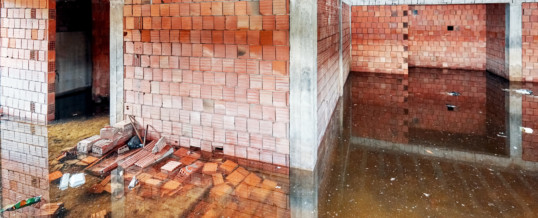
You own a basement. You’ve seen the way that water can infiltrate it. And while you have a general idea as to how it gets inside your home, you’re still a little cloudy on the specifics.
Two words for you: hydrostatic pressure. The entire explanation behind the water in your basement can be summed up with the phrase “hydrostatic pressure.”
Interested in learning more? Then read on. We’re going to get into the details below.
What is Hydrostatic Pressure?
Hydrostatic pressure is the pressure that a fluid exerts against a solid surface due to the existence of gravity. Gravity forces the fluid in a downward direction, causing it to sit flush against a wall, a floor, or, in the case of basements, a foundation.
One of the most common reasons for the cracking of basement walls is the existence of hydrostatic pressure. Groundwater flows down until it meets the outside of a basement wall. Then, hydrostatic pressure causes it to slowly break the basement wall down; eventually, a crack forms.
A cubic foot of water weighs in at around 60 pounds. As such, when it’s storming heavily, there could be as much as tens of thousands of pounds of hydrostatic pressure pushing in on your basement wall.
If there aren’t already cracks existing in the wall, this amount of pressure will cause them to form. If cracks do already exist, this amount of pressure will send groundwater flowing through them at a rapid pace.
As such, the goal of basement waterproofers is not to resist hydrostatic pressure after it has arrived, but to prevent it from presenting itself at all. And while it’s not possible to prevent foundational hydrostatic pressure entirely, it is possible to reduce it.
How to Reduce Hydrostatic Pressure Against a Foundation
There are a number of things that can be done to reduce the amount of hydrostatic pressure against a foundation. The most common methods will be reviewed below.
Utilize Proper Grading
A surefire way to subject a basement wall to substantial amounts of hydrostatic pressure is to have the adjacent yard sloping down toward the home’s foundation. By placing the home at the bottom of a slope, you are essentially inviting water to pool around it. This water is bound to seep down into the ground, applying far too much hydrostatic pressure for the foundation to stand.
Ideally, you’ll position the house so that it’s not at the bottom of a slope at all. But if the home is at the bottom of a slope, there is something you can do: you can grade the yard.
Grading is a process wherein the yard is sculpted and shaped to remove detrimental slopes. It ensures that groundwater is unable to pool around the base of the home, thus reducing hydrostatic pressure substantially.
Install Downspout Extensions
Another thing you can do to reduce hydrostatic pressure around a foundation is to install downspout extensions. These will extend the lengths of downspouts by 10 to 15 feet, ensuring that roof water isn’t able to seep down into the ground around the foundation.
These can be highly beneficial during rainstorms, as they’ll keep precipitation from pooling in unwanted areas.
Implement a Basement Waterproofing System
One of the most common ways to reduce hydrostatic pressure around a basement is to install a basement waterproofing system. A basement waterproofing system is an intricate drainage system consisting of a range of different components, each of which is integral to the system’s overall operation. We’ll review the responsibility of each component below.
1. Drain Tile
Drain tile is a drainage pipe that’s installed underground. This pipe is combined with stone or gravel in order to slow the flow of groundwater and then drain it away from the foundation.
Depending on the way in which the yard and the home are positioned, drain tile systems can be either simple or complex. In either case, they end up emptying toward the end of their corresponding yards.
2. Sump Pit
The sump pit is nothing more than a hole in the ground. That said, it’s an extremely important hole. Dug inside the basement itself, it works in tandem with the drain tile in order to keep hydrostatic pressure to a minimum.
While most basements can make do with one sump pit, some basements require two or more. Your exact needs will depend on the way in which your yard is graded as well as the amount of precipitation you tend to get around the base of your house.
3. Sump Pump
When groundwater levels rise too high, they cause the water levels in the sump pit to rise high as well. This is where the sump pump comes in.
The sump pump is an electrically-powered pump that’s placed either in or above the sump pit. It gauges water levels constantly, ensuring that they don’t get too high. If water levels do get too high, the sump pump turns on, pumping water out of the pit via the drain tile.
Often times, sump pumps are furnished with backup units. These backup sump pumps are powered by battery, allowing them to function in the event of a power outage. By installing both electronically-powered and battery-powered sump pumps, you can prevent basement flooding entirely, all the while keeping hydrostatic pressure to a minimum.
Need Help Combating Hydrostatic Pressure in the Baltimore Area?
Hydrostatic pressure can’t be eliminated. But when it comes to the protection of basements, it can be minimized.
If you’re looking to preserve your basement by combating the hydrostatic pressure around your foundation, there’s no better company to call than Armored Basement Waterproofing. The premier basement waterproofing company in the Baltimore area, we place a deep priority on quality and honesty.
Contact us today to discuss your needs!
ShareMAR
